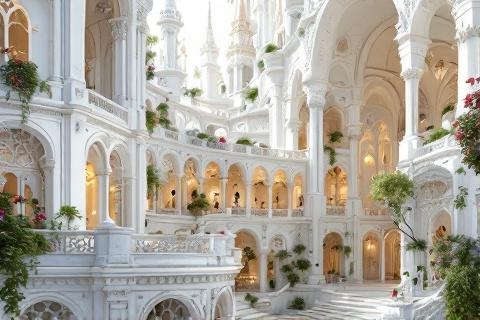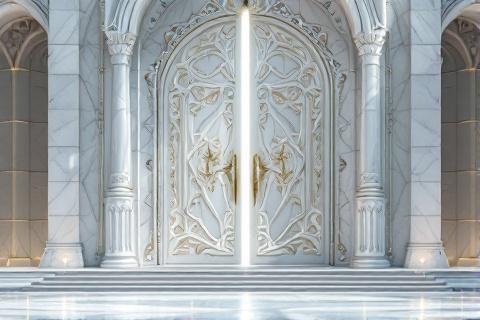
Tirion: The Shining Jewel of Aman
Exploring the Splendor, Lore, and Legacy of the Elven City Beyond the Sea
The Hill of Túna: Foundation of the Shining City

Tirion, the greatest city of the Noldor in Aman, was
majestically situated upon the green hill of Túna in the Pass of Light known as
Calacirya. This sacred pass was the sole break in the mighty Pelóri Mountains,
allowing the light of the Two Trees to reach the eastern coast of Aman and
illuminate the city with holy radiance.
The city's position in Calacirya served both practical and symbolic purposes,
standing as a bridge between the Blessed Realm of Valinor
proper and the eastern shores where many Teleri dwelt at
Alqualondë. This location made Tirion a crucial waypoint
for elves traveling between the inland regions of Valinor and the Great Sea,
establishing it as a center of culture and commerce.
Túna itself rose verdant and fair in the midst of the plain of Calacirya, its
smooth slopes adorned with grass that gleamed with the light of Laurelin and
Telperion. The hill's unique position relative to the towering Pelóri Mountains
created a natural amphitheater that amplified the city's splendor, while its
elevation provided views both westward to Valinor and eastward to the sea where
the stars could still be seen.
Architecture and Urban Design

The walls and towers of Tirion were fashioned from white marble that seemed to
capture and reflect the light of the Two Trees, creating a crystalline
luminescence that gave the city its reputation as the most beautiful of all
Eldarin settlements in Aman. Natural crystals were expertly
incorporated into the construction, their facets catching and dispersing light
in rainbow patterns across the city's surfaces.
Throughout Tirion, the Noldorin architects created a series of graceful terraced
levels that followed the natural contours of Túna. These terraces hosted
elaborate gardens that cascaded down the hill's slopes, creating a harmonious
blend of architecture and nature that showcased the Elves' mastery of both
stone-craft and horticulture.
The seamless integration of Elven craftsmanship with the natural landscape
demonstrated the Noldor's sophisticated understanding of environmental harmony.
The buildings were designed to complement rather than dominate their
surroundings, with graceful arches and delicate spires that seemed to grow
naturally from the hill itself.
The city featured numerous squares and gathering places where the Eldar would
congregate to share songs, stories, and wisdom. These spaces were carefully
planned to create acoustic perfection for music and poetry recitals, while their
arrangement facilitated the free flow of people and ideas throughout the city's
various levels.
The Mindon Eldaliéva

The Mindon Eldaliéva, the Tower of Ingwë, stood as the crown of Tirion, its
white walls rising high above the city in elegant majesty. This tower, built by
the skilled hands of the Noldor, represented the pinnacle of Eldarin
architecture in the Blessed Realm, combining beauty with symbolic significance
as the seat of High King Ingwë of all Elves.
At the summit of the Mindon Eldaliéva burned an eternal beacon, its silver flame
visible even from the shores of Middle-earth in the days
before the world was bent. This light served as a symbol of hope and guidance
for all Eldar, representing their eternal connection to the Blessed Realm even
after many departed for Middle-earth.
The tower's height was unmatched in all of Tirion, its slender form reaching
towards the stars themselves. The Mindon Eldaliéva's proportions were carefully
calculated to create a sense of soaring lightness despite its immense size,
showcasing the architectural expertise of the Noldor.
Ships approaching from the Great Sea would first glimpse Tirion through the
silver flame of the Mindon Eldaliéva, making the tower a crucial landmark for
navigation and a symbolic beacon of welcome. The tower's visibility from such
great distances served as a constant reminder of the connection between the
Blessed Realm and the Outer Lands.
Public Spaces and Halls
Before the Mindon Eldaliéva lay the Great Square of Tirion, a vast open space
paved with sheets of white marble inlaid with crystals that captured and
reflected the light of the Two Trees. This square served as the heart of the
city's public life, where ceremonies, festivals, and gatherings of the Eldar
took place beneath the tower's watchful presence.
The House of Finwë, seat of the High King of the Noldor,
stood proudly near the Great Square, its architecture reflecting the nobility
and wisdom of its inhabitants. The royal residences were marked by their
graceful towers and wide corridors, designed to accommodate the numerous members
of the royal household and their retainers.
Throughout Tirion, halls dedicated to learning and gathering dotted the
cityscape, where the Noldor pursued their passion for knowledge and crafts.
These buildings housed vast collections of lore and served as workshops where
many of the greatest achievements of Eldarin craft were conceived and created.
The markets and craftsmen's quarters of Tirion were renowned throughout Aman for
their exceptional products and innovations. Here, the Noldor's love of
craftsmanship and invention found its fullest expression, with workshops
producing everything from delicate jewelry to powerful artifacts imbued with the
skill and magic of their makers.
The City Gates and Walls

The main gates of Tirion were architectural marvels that combined defensive
strength with breathtaking beauty, featuring intricate carvings that told the
story of the Eldar's Great Journey to Aman. These gates, though primarily
ceremonial in the peaceful realm of Aman, demonstrated the Noldor's mastery of
metalwork and stone-craft.
The city's fortifications seamlessly merged defensive architecture with
aesthetic grace, creating walls that appeared more like works of art than
military structures. The smooth white surfaces were adorned with delicate
traceries and geometric patterns that caught the light in ever-changing ways.
The construction techniques used in Tirion's walls and gates showcased the
Noldor's innovative use of crystal and marble together, creating structures of
unprecedented strength and beauty. The stones were fitted so perfectly that the
walls appeared to be carved from single pieces of marble, while crystal elements
provided both structural reinforcement and decorative enhancement.
Gardens and Natural Elements

The hanging gardens of Tirion were among the city's most remarkable features,
with terraces of greenery cascading down Túna's slopes in carefully planned
arrangements. These gardens combined native plants from Aman with specimens the
Eldar had brought from their journey westward, creating living memories of lands
both old and new.
Throughout the city, fountains and waterways created a symphony of flowing water
that complemented the natural music of Aman. These water features were
engineered with exceptional skill to provide both practical irrigation and
aesthetic pleasure, their sound and movement adding to the city's peaceful
atmosphere.
The flora within Tirion's gardens included a diverse array of plants unique to
the Blessed Realm, many of which grew nowhere else in Arda. Golden and silver
flowers reminiscent of the Two Trees bloomed in abundance, while fragrant herbs
and fruit-bearing trees provided both beauty and sustenance.
The relationship between Tirion's built environment and its natural elements
reflected the Eldar's deep respect for Yavanna's works. Buildings and gardens
were designed to complement each other, creating spaces where nature and
architecture existed in perfect harmony, exemplifying the Elves' role as
guardians and enhancers of the natural world.
